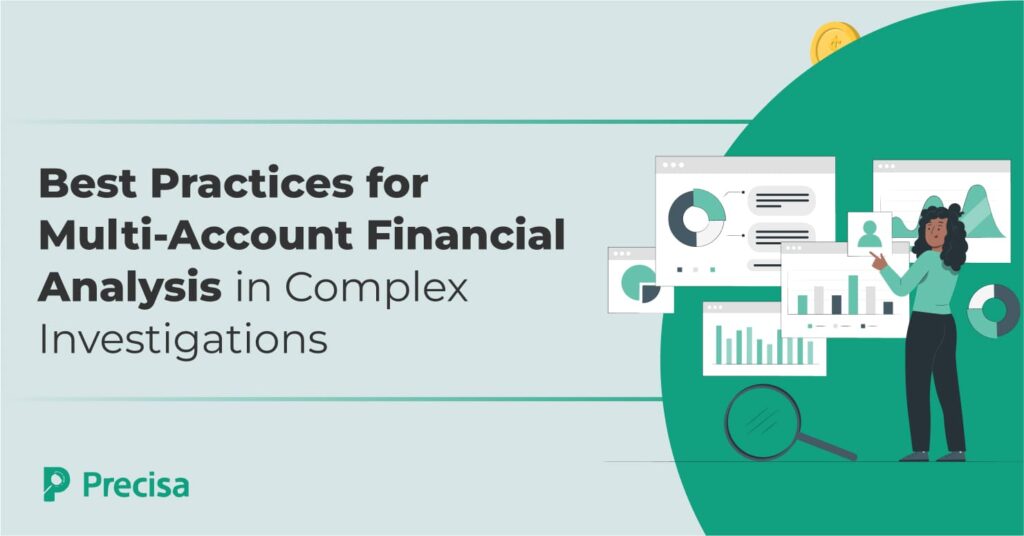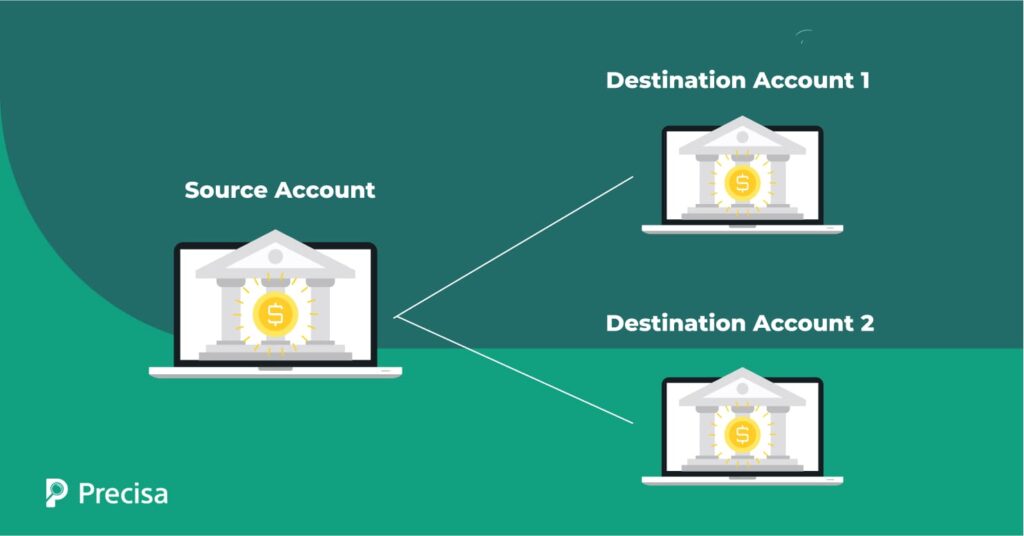Best Practices for Multi-Account Financial Analysis in Complex Investigations

21st-century financial fraud leaves, not just one, but numerous digital footprints across multiple banks, wallets, and payment platforms. Today, investigators face suspects who split transactions across 5 to 20 different accounts to obscure money trails. What once involved tracking cheques and cash deposits now requires analysing UPI transactions, NEFT transfers, and cryptocurrency movements all at the same time.
One of the main reasons why traditional financial analysis struggles with this complexity is the manual examination of multiple bank accounts. This can take 30 to 45 days, making it nearly impossible to meet investigation deadlines or prevent ongoing fraud.
India’s banking system lost ₹36,014 to fraud cases in FY 2024-25, with digital payment scams forming 56% of the cases.
Modern forensic teams need technology that matches the sophistication of financial criminals. Platforms like Precisa’s AI-powered multi-account financial analytics enable forensic teams and government officials to process multiple accounts in 25 to 30 minutes instead of weeks, providing the speed and accuracy that complex investigations need.
Challenges in Multi-Account Financial Analysis
Consider a typical investigation scenario: A subject has accounts in five different banks, multiple UPI apps, and credit card lines. Each financial institution provides statements in different formats, with varying levels of detail and structure.
Here’s why multi-account financial analysis teams face multiple hurdles when examining such cases:
- Over 500 banks operate in India, generating more than 1,000 different statement formats, field names, layouts, and even languages. Handling, analysing, and comparing millions of transactions manually is practically impossible when working against tight legal and regulatory deadlines.
- Humans can miss subtle irregularities, overlook frequent small transactions, or fail to recognise complex circular transfers. Cross-referencing transfers, such as matching transactions across accounts, between bank vs UPI vs credit card, or even between scanned and digital statements, requires painstaking attention.
- Teams need significant investigative resources to identify counterparty relationships hidden across multiple institutions. Manual intelligence simply cannot match the volume and complexity of modern financial data.
These challenges make it clear: effective multi-account financial analysis requires combining human expertise with technological efficiency.
Best Practices for Forensic Teams in Complex Investigations
Based on successful implementations across forensic teams, here are the practices that deliver results:
1. Automate Data Extraction and Standardisation
The foundation of accurate multi-account analysis is converting every input into a unified format. Teams should implement automated bank transaction analysis tools that instantly process PDFs, scanned documents, and JPG/PNG images from any bank into machine-readable Excel sheets. However, ensure format conversion preserves data integrity, as in no dropped rows, fields correctly mapped, and dates standardised.
Automated extraction brings down the 30 to 45-day processing time to 25 to 30 minutes. Modern bank statement analysers can handle password-protected statements, scanned documents, and digital files with equal efficiency.
This standardisation creates a consistent framework for cross-account analysis, ensuring no transaction falls through the cracks due to format inconsistencies.
2. Implement Cross-Account Aggregation

Financial analysis in a complicated investigation involves tracing how money flows between different banks and spotting patterns that single account might overlook. So, once data is standardised, aggregate all accounts to get a holistic view, and not look at each in isolation.
Advanced analytics tools use FIFO (First-in-First-Out) tracking to map source-to-destination flows across accounts. This helps uncover hidden links that suspects try to hide through multiple transfers.
Automated counterparty detection sums up transactions, recurring relationships, frequent counterparties, or hidden entities, while visual mapping, in the form of graphs and flow diagrams, turns messy transaction data into clear trails that forensic experts can follow.
When you systematically aggregate accounts, inter-bank transfers become crucial evidence rather than confusion. Building complete financial profiles from scattered data helps reveal patterns and intent in fraud cases.
3. Leverage Advanced Pattern Recognition
Human reviewers can miss suspicious patterns buried in thousands of transactions. Automated financial analysis tools support multi-level instant checks, which help detect anomalies that manual reviews overlook and provide investigation-ready alerts.
Modern pattern recognition identifies circular transactions where funds loop back to their origin through intermediate accounts. Applying UPI transactions filters enable teams track Reference Number (RRN) patterns to spot coordinated activities across platforms, while smart categorisation helps distinguish between legitimate business payments and suspicious round-figure transfers.
Using transaction volatility analysis allows flagging of accounts that suddenly shift from dormant to highly active or experience dramatic balance fluctuations. Further, leveraging multi-level recognition capabilities helps examine sequences and relationships and not just individual transactions.
4. Ensure Comprehensive Transaction Intelligence
To ensure forensic investigation works effectively, financial analysts must understand the nature and purpose of transactions more than their date and time of occurrence. Detailed categorisation in bank statement analysers helps separate salary deposits from loan disbursements, EMI payments from business expenses, and legitimate recurring charges from suspicious patterns.
Your financial analysis should include salary identification and verification to distinguish employment income from other fund sources. EMI payment tracking can reveal financial obligations and spending patterns, while recurring payment and deposit analysis can help separate routine transactions from anomalies.
Monitoring utilisation of OD/CC (Overdraft / Cash Credit) limits, such as sudden spikes, repayments, misuse, and identifying declared loans, advances, or liabilities helps understand what the subject owes or receives.
On the other hand, cash flow analysis distinguishes business vs personal expenses, especially for applicants who are self-employed or have mixed transactions. Furthermore, tracking available balance over time answers questions like how often does balance drop below certain levels or does the subject maintain a comfortable buffer or how often do large overdrafts happen.
5. Use AI-Powered Analytics
Modern financial investigations need tools that go beyond rules and manual filters. AI and ML-powered platforms, like Precisa, provide speed, accuracy, consistency, and detail.
Precisa’s intuitive financial analytics for forensic investigators provides forensic teams with a specialised investigation dashboard explicitly designed for complex financial analysis. It offers the following features:
- Irregularity Tracking: Consolidates over twenty-five irregularity indicators into actionable insights to help forensic auditors and Income Tax and GST departments identify suspicious activities within minutes of uploading bank statements.
- Precisa Score: The proprietary algorithm evaluates creditworthiness by combining many signals, including volatility, OD/CC usage, and circular transactions.
- Counterparty Analysis: Provides both overall and monthly views of entities transacting with your subject. You can instantly see top counterparties by volume and value and reveal hidden business relationships or coordinated fraud networks.
- AML Analysis: Uses FIFO logic to trace suspicious transaction chains. The Anti-money laundering module automatically flags accounts with drastic balance fluctuations, such as those jumping from ₹50 lakh to ₹500 within days.
- Monthly withdrawal graphs & Transaction Mode Analysis: Help you understand spending patterns and payment preferences. The intuitive platform compares transaction volumes against monthly averages, highlighting dormant accounts that suddenly activate.
- Interbank Transfer Visualisation: Shows graphical representations of fund movements between banks, making complex money trails detectable.
- Precisa’s bank statement analyser also helps reduce false positives while catching unusual cases, such as patterns that are rare but legitimate vs patterns that are subtle but suspicious.
- The platform supports API integration and account aggregator connectors so that forensic teams, lending institutions, and government agencies can plug the tool into their existing workflows.
Key Takeaway
Modern financial scams are conducted by sophisticated fraudsters across multiple accounts, different payment modes, and complex transaction patterns. To keep up, investigators need even better, sophisticated solutions that automate the tedious parts and amplify human insights. AI-integrated machine-learning tools make multi-account financial analysis faster, more accurate, and far more reliable.
Precisa’s cloud-based financial data analytics solution transforms forensic investigations by cutting down processing time drastically (from weeks to 30 minutes), standardising data across 1000+ bank formats, revealing hidden counterparties, performing advanced pattern recognition (including circular transactions, UPI/RTGS anomalies), and providing comprehensive dashboards with Precisa Score, Volatility Score, FIFO, and irregularity metrics.
To date, Precisa has analysed over 15 lakh bank statements and 2.32 crore transactions for more than 300 financial institutions across 21 countries. A few notable clients include National Forensic Sciences University, DGGI, Growmor, ftcash, Bengaluru City Police, Punjab Special Forces, and Tata International.
Schedule a demo with Precisa to see how instant, AI-based multi-account financial analysis can change your audit workflows.



